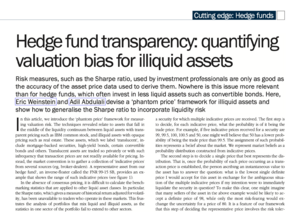Hedge fund transparency: quantifying valuation bias for illiquid assets
The 2002 paper "Hedge Fund Transparency: Quantifying Valuation Bias for Illiquid Assets" by Eric Weinstein and Adil Abdulali introduces a framework called "phantom pricing" to address the challenges in valuing illiquid, or "translucent," assets. These assets lack consensus pricing due to infrequent or private trading, which complicates the use of standard risk measures like the Sharpe ratio. The authors propose treating pricing uncertainty as an additional risk that investors should be compensated for. They present a two-step approach that uses probability distributions derived from indicative price samples to estimate a "phantom price," reflecting a risk-adjusted valuation based on investor preferences.
The paper explores how this phantom pricing framework can adjust traditional risk metrics, revealing biases in reported asset values, especially when fund managers smooth return volatility by selectively marking prices. By applying this approach to a sample portfolio, the authors show how phantom prices can offer a more nuanced assessment of risk-adjusted returns, providing insight into manager practices and pricing aggressiveness. The framework is positioned as a tool to improve transparency and offer a more accurate comparison of fund managers’ performance when dealing with illiquid assets.
Summary by Section
Introduction
The paper introduces a framework called "phantom pricing" for measuring valuation risks associated with illiquid assets. These assets, termed "translucent," fall between liquid and highly illiquid assets. The lack of consensus on pricing for such assets complicates the use of traditional risk measures like the Sharpe ratio. The authors propose treating the uncertainty in pricing as an additional risk factor for which investors should expect compensation.
Our Approach: Introducing the Phantom Pricing Framework
The approach begins by using a collection of indicative prices for a given security. These prices are treated as a sample from a probability distribution, with the task of estimating the probability of each price being the actual trade price. The concept of a "phantom price" is introduced, representing a risk-adjusted value that accounts for investor risk preferences and market beliefs.
Representing Investor Market Beliefs
Investor beliefs about the prices are modeled using probability distributions. Since negative prices are not feasible, gamma distributions, supported on the non-negative real numbers, are used. The distribution's parameters (shape and scale) are derived from the sample mean and variance of the indicative prices.
Representing Investor Preferences
The paper uses the Von-Neumann-Morgenstern utility theory to incorporate investor preferences. A risk preference model with a utility function that exhibits decreasing absolute risk aversion is employed. Phantom prices are computed as certainty equivalents of the indicative price distribution, depending on the investor’s relative risk aversion coefficient.
Bounded Assets
For assets with inherent price bounds (e.g., options with embedded floor or cap prices), the approach adapts to use generalized Beta distributions instead of gamma distributions. This ensures that phantom prices remain within the security's possible valuation range.
Sample Application
The authors demonstrate the phantom pricing framework using a hypothetical portfolio comprising mortgage derivatives and Treasury notes. They calculate phantom prices for various levels of investor risk aversion and compare them with traditional Sharpe ratios to highlight potential biases in manager-reported performance.
Phantom Price Sharpe Ratio versus Manager Sharpe Ratio
The paper explores how phantom prices can reveal biases in reported asset values. When managers use the extremes of received price quotes to smooth the apparent volatility of returns, traditional measures like the Sharpe ratio may overstate performance. The phantom price Sharpe ratio adjusts for this by considering a range of possible values, offering a more nuanced view of risk-adjusted returns.
Manager NAV/Phantom Price NAV
This section discusses using the ratio of the manager's reported Net Asset Value (NAV) to the phantom price NAV as a measure of aggressiveness in pricing. If the ratio equals one across all risk aversion levels, it indicates consistent valuation relative to indicative prices. Deviations from one can signal conservative or aggressive pricing practices.
Extensions of the Approach
The paper outlines further developments to the phantom pricing framework:
- Asset Integration Hypothesis: Risk tolerance may vary with changes in wealth, even if an investor’s risk preferences remain constant.
- Portfolio Aggregation: Aggregating phantom prices for an entire portfolio involves complex probability calculations.
- Testing for the Coefficient of Relative Risk Aversion: Investors can use a series of questions to assess their risk preferences, which then informs the calculation of phantom prices.
Conclusion
The paper concludes by emphasizing that the lack of consensus pricing for translucent assets introduces an additional risk that investors should be compensated for. The phantom pricing framework provides explicit methods for accounting for this risk in portfolio evaluations, extending traditional metrics like the Sharpe ratio to more accurately reflect the risks of illiquid assets.
The paper aims to provide a tool to help investors better understand the discretionary practices of fund managers in valuing translucent assets and offers a yardstick for comparing fund managers’ performance more equitably.
